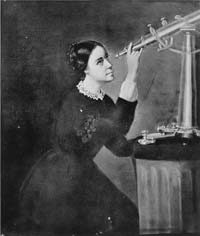
| Born: Aug 1, 1818 in Nantucket, Massachusetts |
| Died: June 28, 1889 (at age 70) in Lynn, Massachusetts |
| Nationality: American |
| Field: Astronomy |
| Famous For: First female U.S. professional astronomer, Discovery of C/1847 T1 |
Maria Mitchell was the first female professional astronomer in the United States. In 1847, she discovered what became known as “Miss Mitchell’s Comet,” and was consequently awarded a gold medal by the King of Denmark. She was a strong supporter of girls’ education, a view she shared with her father. In 1994, Mitchell was elected to the National Women’s Hall of Fame.
Early Life
Mitchell was born into a large Quaker family in Nantucket, Massachusetts on August 1st, 1818. Her parents’ religion influenced their support for education for both sexes. As a result she was given a better education than most other girls. Nantucket was a whaling port, and the necessity for men to be at sea for long periods meant that women were used to managing affairs at home. Even so, they still had no rights to vote or own property, something which infuriated the young Maria.
Mitchell was sent to school at North Grammar, where her father had been principal. She was then sent to a new school that her father had built himself. As well as studying there, Maria also assisted with teaching. Away from school, she learned about astronomy from her father, helping him in calculating the timing of an eclipse. Her interest in education persisted, and in 1835, while still a teenager, she opened a school of her own while also working as a librarian.
Discovery of a Comet
On October 1, 1847, Mitchell discovered the comet that was later named after her. Because it was too faint to be seen without a telescope, this qualified Mitchell for one of the gold medals given by Frederick VI of Denmark. Mitchell thereby became only the second woman to win this prize, the first having been Caroline Herschel a few years earlier. She formally accepted the award the following year.
Also in 1848, Mitchell was elected to the American Academy of Arts and Sciences, the first woman to receive that honor. Two years later, she was also admitted to the American Association for the Advancement of Science. A little later, she took a post at the Nautical Almanac Office, where her job involved calculations relating to Venus’s position. Away from her career, she traveled to Europe, accompanying Nathaniel Hawthorne.
Later Life
In 1865, Mitchell began to work at Vassar College where she was the inaugural professor of astronomy. She was also the college observatory’s director. She became angry when, after a few years at the college, she discovered that a number of younger and less experienced men were being paid more than her for similar professorial roles. After this had been revealed, Mitchell pushed for an increase in her salary. Eventually the school increased her pay.
By now Mitchell had drifted away from her original Quaker beliefs, having become a Unitarian in 1842. She was a vocal opponent of slavery, refusing to wear cotton garments because of the involvement of slave labor in their manufacture. She was also a strong supporter of women’s voting rights, co-founding an association dedicated to female improvement and advancement. Mitchell died in June, 1889, and was buried in Nantucket. An observatory in that town is named in her honor, as was a Liberty ship in World War Two and, later, a lunar crater.